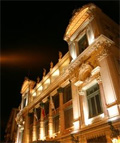When it comes to art, musical or otherwise, never be overcome by prejudices! Especially when a creation is announced whose mere name wrongly has the power to scare off the sometimes too traditionalist audience of the Opera. Such was indeed the lesson on Friday evening at the Nice Opera after a concert by its Philharmonic given as part of the national operation “Orchestre en fête”. An event lasting about ten days organized by the Association of French Orchestras aimed at “highlighting” the activity of instrumental formations. Multiple drawings from children asked to “imagine the decoration of the theater” were hung in the Opera foyer. The program announced a creation by Argentine composer Martin Matalon “Trame IX, for solo oboe and orchestra” followed by the 7th Symphony of Dmitri Shostakovich, called “Leningrad” because it was composed during the invasion of the Soviet Union by Nazi armies. One might say that this was perhaps not entirely for the little ones.
Having studied with Olivier Messiaen and Pierre Boulez, Martin Matalon is a child of the Juilliard School in New York, a reference in music and singing. But the real key to this composer’s work probably lies in the influence of the poet and compatriot Jorge Luis Borges and the filmmaker Luis Buñuel: we may then better understand why his “Trame IX for solo oboe and orchestra” captivates with its suggestive power where each measure evokes a mental representation for the listener, an image, a scene, a feeling. Strangely, the author thinks in purely plastic or even graphic terms: when questioned about his inspiration, he mentions “lines,” here “atomized,” there “cumulative,” “circularities that revolve around themselves,” “mobiles.” A “line,” as magnificently rendered by the soloist François Meyer before it is “dramatically broken by a timpani solo” at the end of the work where it becomes “dotted,” elusive, and completely fades away. Far from deliberately dissonant musical agitations, Martin Matalon offers a meticulous approach, a fine musical architecture, an airy sequence of pastel harmonies, a succession of colors — a legacy of Messiaen? — that is pleasantly audible to ears often “formatted” to classical tonalities. His work extends a hand rather than capturing, sharpens more than it tears away, suggests more than it provokes, knowing how to soften the fortissimo or hold back the crescendo before their ultimate stage. The frantic race of the solo oboe — this “line” the author speaks of — engages in a sometimes breathless dialogue with the various instrumental formations of the orchestra subtly conducted by Maestro Marco Guidarini. The cellos multiply imperceptible sustained notes while the double basses maintain others in a muted tone, “crushed” as the score requires. Astonished, charmed, and eventually won over, the audience showered praises at intermission for this very promising young talent.
The 7th Symphony by Dmitri Shostakovich, in the second part, is almost the exact opposite: a solemn, heavy work, which its detractors might call clumsy as it sometimes resembles those heroes with massive features painted during the era of socialist realism, entrusted with glorifying the apparent successes of the regime. It’s unclear whether to call the composer Russian or Soviet because of the ongoing debate about the hidden meaning of this work: during Operation Barbarossa launched in June 1941, which led to the terrible siege of over 1,000 days of St. Petersburg, renamed “Leningrad” for the occasion, the composer announced on local radio in September 1941: “I finished an hour ago the score of two movements of a large symphonic composition… I want listeners who are listening to me now to know that life in our city continues normally.” This did not prevent Shostakovich from already being suspected of “leftist chaos” for his “Lady Macbeth of Mtsensk” in 1936 before being accused of “musical formalism” by Zhdanov in 1948! Some even saw a disguised critique of Stalin’s insidious rise to power in this symphony.
This 7th Symphony somewhat resembles the painful life of the composer, alternately harassed and rehabilitated, only to be marginalized again by the USSR leaders, according to an enlightening lecture by Samy Camps, a musicology student at the University of Nice. In the first movement, while the “snare drum” rhythmically establishes a military cadence, flutes, violins, and then double bass pizzicatos each take their turn with the famous theme that evokes an army on the march. Until it becomes infernal when the percussion seems to convey the frontal clash of the conflict. The third movement illustrates this extreme dramatization, fortified by the projection on a rear screen of images about the harshness of war drawn from ECPA archives: the poignant accents are created by the relentless rise of the strings, accentuated majestically by the brass. But it is in the fourth and final movement, where the composer’s orchestration work intertwines the interventions of the various sections of the orchestra, that the Nice Philharmonic fully showcases its efforts. And its talent.


